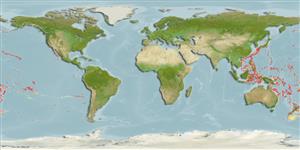Environment: milieu / climate zone / depth range / distribution range
Écologie
marin bathydémersal; profondeur 335 - 490 m (Ref. 41739). Deep-water
Pacific Ocean: Japan and Hawaii. Recently reported from the Chesterfield Islands (Ref. 11897).
Taille / Poids / Âge
Maturity: Lm ? range ? - ? cm
Max length : 21.0 cm SL mâle / non sexé; (Ref. 559)
Épines dorsales (Total) : 6; Rayons mous dorsaux (Total) : 16; Rayons mous anaux: 26. Maxilla without tentacle. Spinous dorsal fin never jet black (Ref 12932).
Benthic on sand and rock (Ref. 58302).
Life cycle and mating behavior
Maturities | Reproduction | Spawnings | Egg(s) | Fecundities | Larves
Masuda, H., K. Amaoka, C. Araga, T. Uyeno and T. Yoshino, 1984. The fishes of the Japanese Archipelago. Vol. 1. Tokai University Press, Tokyo, Japan. 437 p. (text). (Ref. 559)
Statut dans la liste rouge de l'IUCN (Ref. 130435)
Menace pour l'homme
Harmless
Utilisations par l'homme
Outils
Articles particuliers
Télécharger en XML
Sources Internet
Estimates based on models
Preferred temperature (Ref.
123201): 7 - 13.3, mean 9.8 °C (based on 103 cells).
Phylogenetic diversity index (Ref.
82804): PD
50 = 0.5156 [Uniqueness, from 0.5 = low to 2.0 = high].
Bayesian length-weight: a=0.00372 (0.00153 - 0.00904), b=3.10 (2.89 - 3.31), in cm total length, based on LWR estimates for this (Sub)family-body shape (Ref.
93245).
Niveau trophique (Ref.
69278): 4.1 ±0.5 se; based on size and trophs of closest relatives
Fishing Vulnerability (Ref.
59153): Low vulnerability (16 of 100).
